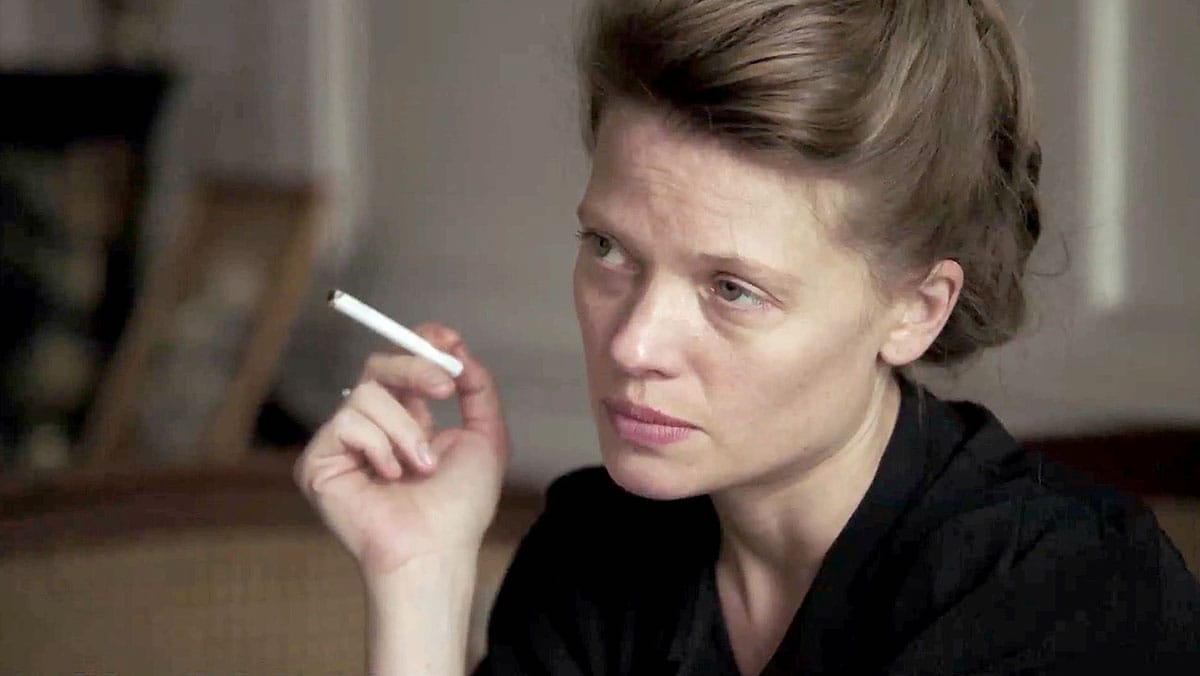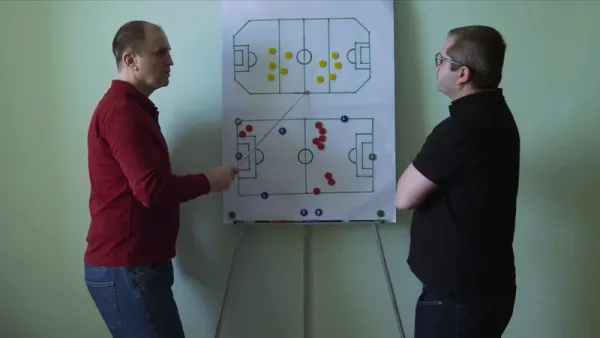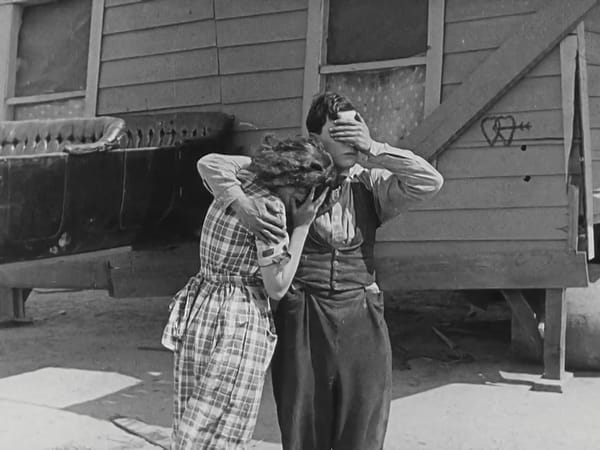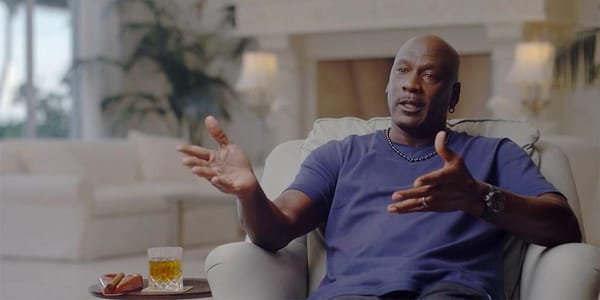“She doesn’t just tell us a story, she tells us about a feeling”

“She doesn’t just tell us a story, she tells us about a feeling”
A conversation with French director Emmanuel Finkiel about his film Memoir of War, adapted from a Marguerite Duras novel, where feelings are as treacherous as words
Mélanie Thierry plays a version of Marguerite Duras herself in Emmanuel Finkiel’s Memoir of War, simply called La Douleur in France. This is indeed a story of suffering, centred on a woman in Nazi-occupied France who waits so long, hoping for her husband Robert (Emmanuel Bourdieu) to return from the camps, that she comes to find herself almost entirely defined by and even attached to her pain. Duras explored disturbing emotions that she was herself grappling with, and Finkiel’s adaptation boldly brings to the screen all the levels of reality that her fictionalised alter-ego exists on as she struggles with her often contradictory emotions.
This interview was conducted in 2019.
Elena Lazic (EL): This is the first time you’ve adapted a novel. Why this one in particular?
Emmanuel Finkiel (EF): First of all, it was suggested to me. I don’t think I ever would have dared tackle the work of Marguerite Duras otherwise, and especially not this particular novel, because it is in some ways autobiographical, too.
But that’s not the only reason. This novel is one I had discovered a long time ago when I was about 25 years old, and it had completely overwhelmed me at the time for very personal reasons. It was because what I saw described in the novel, in all its complexity and nuance, was something I had been witnessing since I was a child, when looking at my father. During the Occupation, in 1942, his parents and his younger brother were arrested and deported, and they ended up in Auschwitz. But my father, who was 15-years-old at the time and had stayed behind, just started to wait for them. He didn’t know that they weren’t coming back. When he learned that the people who went there didn’t come back, he didn’t have proof. He kept waiting, and throughout the years, I saw that my father was always in some way waiting. It was an unreasonable wait, for obvious reasons. But what I saw was someone enveloped by absence. I don’t know how else to put it. And at the time, I couldn’t put this into words. When I read La Douleur by Marguerite Duras, I saw in it words that described the same thing, the same madness. Because it is a form of madness, in a way.
EL: How did you work on adapting the novel?
EM: I think that, for as long as possible, I tried not to use my intellect, but to instead be a receptor, open to my own reading of Duras, to see the effect it had on me. Sometimes, images would come to me, and I’d write them down. Other times, it would suggest feelings or emotions. And I started from there. It was not an intellectual work of trying to understand the essence of the novel. No, I wanted to confront myself directly to my own reading of it, because I hadn’t read it since I was in my twenties. I tried to see the effect it would have on me, to use myself as a test subject. And I often say that I didn’t adapt the novel. I only adapted my own reading of the novel. It seems like a stupid thing to say, because every adaptation works this way, but it’s good to remind people. If there was something I had forgotten or that didn’t interest me, it didn’t appear in the script.
EL: Did this script change once it came to filming?
EF: No. Only one fundamental element evolved, and that’s the voiceover. In the final version, it is very present. But when I was writing the film, I never thought there would be so much of it. It only appeared in three moments, where it was required by the narration. But it wasn’t at the very surface of the sensations. It was while filming with Mélanie, at the end of the shoot every day, while sitting at a table like we are now, that we worked on the first voiceovers. With trial and error, she eventually found the rhythm, and then the tone. Listening to her made me want to add a little more voiceover. And then, during the editing, I realised that I really liked it. So I started to imagine other moments where it could be included, and it all came together little by little.
EL: How did you find the right balance, so that you wouldn’t rely on the voiceover too much or make it too descriptive?
EF: I thought it would be interesting to have a sort of dialectic between the voiceover and the image, and the sound too, with the noises of the city coming through between her voiceover words when she’s in the street, for example. That it would be like a dialogue. Sometimes, the image would correspond to the voiceover, like a pleonasm. Other times, there’s a gap. For example, near the end of the film. She is heard saying “Robert got up, and I walked towards him.” and we see her walk towards him. But Robert gets up late. It means that she said that Robert got up before he actually did. The viewer can see that. I really liked this, because it’s as if she was the one who made him get up, as if he was following her words. It’s very subtle, you really have to be in the film to notice, but I really like it.
EL: I like it, because during almost the entire film, all she does is wait. And here, at the end, she begins to make decisions about their lives. It’s a great contrast with everything that came before.
EF: You know, this abruptness that is almost a choc, it is there in Duras’ writing. For about 98% of the book, she is in this state of waiting. And then, there is this ending. When I was 25 years old and I read it, that was when the tears began. And that was the part that made me think of my father. There’s probably something quasi-psychoanalytic to this, I have no idea. But in any case, Duras wrote something that is formidable for its nuance and complexity. She doesn’t just tell us a story, she tells us about a feeling, one that we all know, no matter our story: pain. We’ve all experienced it, even just a part or a facet of it. We know what it is. And Duras is writing for the people who know perfectly well what it is. That’s why she allows herself to go into its subtleties, which, for some, can seem troubling. Some people, for example, reacted pretty badly to the film’s ending. But Duras chose to show herself in the novel warts and all, even if it meant being insulted and criticised. She showed herself in all her complexity, with feelings that, like all human emotions, cannot be described in just a few words.
EL: The character begins the film saying that she misses her husband, that she has this pain. But later, she realises that she might be more attached to that pain than to him. There is a duality to her. But there is also another level to this, since the character is also a version of Marguerite Duras. There are at least three levels at play. We are always by this character’s side, but she lies to herself, and she lies to us. How did you choose to make all these levels visible?
EF: It began when I was starting to adapt the novel, and I read a passage where she described her reaction to a phone call, saying that she threw herself crying to Dionys’ feet (Benjamin Biolay). She wrote “it was coming out of everywhere, from my nose, from my eyes.” At some point, I thought “If I have to ask an actress to do this, I won’t know how, because I don’t understand it. I don’t believe it.” I thought she was putting on a show, not to say acting up. The same way we often do — we lie to ourselves, and to better lie to ourselves, we embrace the outward expression of a feeling which, deep within ourselves, we may not be feeling at all. I thought erasing that just because I didn’t believe in it would be giving up on some of the madness of the novel. That is when I thought, let’s have two of her: one who rolls on the ground crying, and the other who doesn’t. That way, she shows us that she is no fool. That she knows she is putting on a show for herself and for Dionys.
To better answer your question, the idea came when I realised that Marguerite Duras was lying. I checked in her biography what she was doing at the time described in the novel, those three or four weeks in 1945, and I realised that she was worrying about the edition of some book, or something like that. That she was living with Dionys as a couple, almost officially so. It had nothing to do with what she’d written. I chose to follow the novel anyway, because this wasn’t a biopic. But from my surprise remained this idea of duplicating the character. Meaning, she is no fool. At the end, one of them runs down the stairs laughing, and the other remains. Which one is real? We do the same thing with our minds, projecting ourselves in the stairs while we stay still. We imagine we’re moving, but we’re not.
It is this sometimes contradictory duality that is, I think, the source of this pain. It causes guilt, even shame. The theme of shame is present throughout all of Duras’ work. In Hiroshima mon amour, it is possible to argue that the real theme of the film isn’t humanity’s guilt regarding Hiroshima and Nagasaki, but maybe it is the story that the character is telling from before Japan, about how she was in love with a German soldier, then was shaved and locked in a cave for it. That is the source of her shame. That’s why I decided to put the story of the liaison with the collaborator cop (Benoît Magimel) first, even though in the novel, it happens later — to show that this, too, was a constituent of her pain later, when she locks herself in the flat and loses her mind.
EL: Mélanie Thierry carries the film on her shoulders, there are many scenes of her alone. Her subtle performance shows she perfectly understood the novel. How did you work with her?
EF: She was an ideal partner for me. She allowed me to work in a way I really like. I believe that even when making a very scripted work of fiction, one cannot forget what is the essence of cinema — meaning, documentary. In fiction, you’re still filming the apparition of someone. A work of fiction is made of several documentary cells. That means she wasn’t acting. She was trying to embody. When she arrived to set in the morning, with her costume and no makeup — she never wore makeup, except when the character was putting some on herself — it wasn’t Mélanie Thierry arriving, it was the Marguerite created by Marguerite Duras. Moreover, whenever I can, I try not to use artificial lights. I’ve already decided on the sequence of shots, but still, I work like it’s a documentary. And so we begin filming, without doing rehearsals. We never do rehearsals, we just agree on the set ups, etc. And then, while we’re filming, I talk to her. People are wrongly taught not to do in French film schools, but I think that’s the best advice you can give someone, and digital cameras make it very easy.
When you watch the rushes, you can hear me talk. And something that is beautiful to see is that, when I tell Mélanie to do something, she doesn’t do it immediately. It was like sending a message to Mars — there was a delay, it took time. She would receive the message, and it would go through her body. “Go towards the door and open it.” She hears this, and then, when she goes to open the door, we believe that there is someone behind it. That was how we worked. We talked, a bit like on Fellini’s sets. When I worked as an assistant director, Marcello Mastroianni told me, “It’s funny. In France, there’s a lot of mess and noise, and when someone says ‘action,’ it’s complete silence.” He said that, with Fellini, it was the opposite. Everyone worked in practically religious silence, and when filming began, people started shouting — the technicians would give orders, and Fellini would be talking, too. I think that digital cameras allow us to return to something a little similar. Because film, which was really expensive, eventually forced us to do like at the theatre, to put everything in place and rehearse, rehearse, rehearse. Digital allows us to capture the first time. The first time Mélanie looks out the window, for example. I didn’t always use the first takes, but they were the basis for the others. The basis is always something spontaneous.
EL: Mélanie said that you didn’t do a lot of takes while filming, but that there were a lot more takes to record the voiceover.
EF: Yes, because there is a very particular phrasing to Duras’ writing, but also particular pronunciations by the great French actresses who played her characters: Jeanne Moreau, Delphine Seyrig and of course Emmanuelle Riva in Hiroshima, Mon Amour. Riva’s voice in that film is like a chant of sorts. And I realised while working on Duras’ text, that it wasn’t so much that the actresses had exaggerated anything or that the directors had asked them to speak a certain way, but that this peculiar way of talking was inherent to Duras’ writing, even in her silences. Even if you read, let’s say, half a page in ten seconds, it feels and sounds like it is taking a lot longer, because there are silences in there that the brain understands, even if you do not respect them while you read. In cinema, we are in real time, so we extended the silences between Mélanie’s sentences. But we also had to find something that wouldn’t be an imitation or a copy of what has been done before. Something that would capture something of Mélanie’s personality, as well as the timelessness of Duras’ text.
EL: It is true that Marguerite Duras has a very particular way with words.
EF: Yes, in her use of obsessive repetitions and short sentences. It is very direct. A short and striking sentence is often followed by a silence.
EL: How did you develop this method of talking to the actors while filming?
EF: It happened just like that. But it was also based on what I saw other directors do. For example, I learned a lot while working alongside Krzysztof Kieślowski on the Three Colours trilogy. His focus and his attention when an actor was playing in front of the camera made up 80 percent of his work directing actors. Since the actors knew they were being watched and seen, they did not feel like they had to offer an exaggerated performance. And so this gaze that never leaves the actor no matter what, I learned it with Kieślowski. Of course, he didn’t talk while filming. But the bridge was already there, meaning the attention given to the actors and the fact that we are making this shot together, live. Fiction allows for repeated takes, it isn’t really live. But it is like documentary in the sense that when you film three takes, you film three live takes. You are still in the same fragility as live recording, if you’re looking for things that belong to the order of real life.




